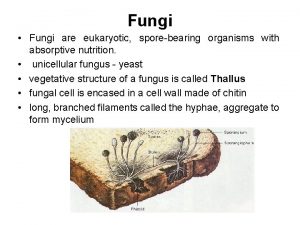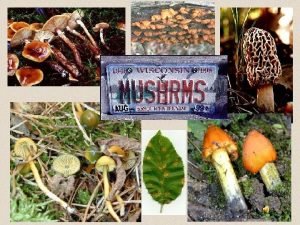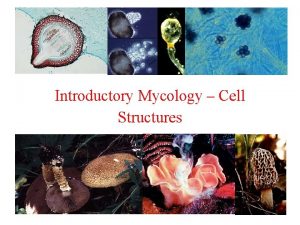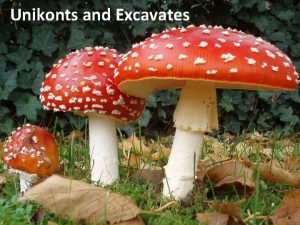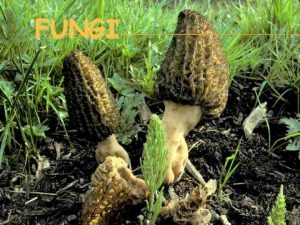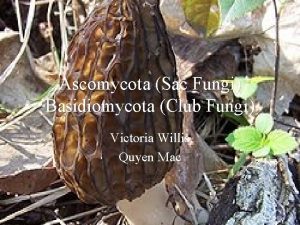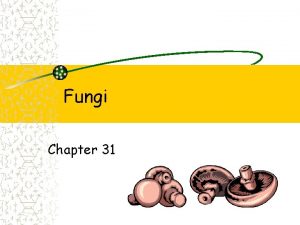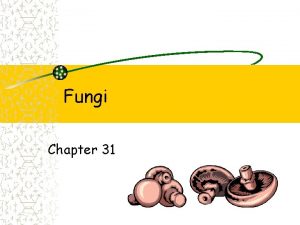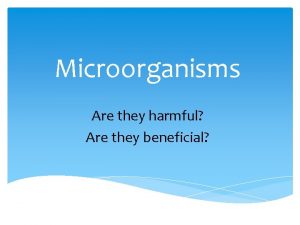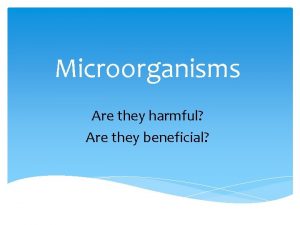Fungi What are they w Eukaryotic microorganisms w







- Slides: 7

Fungi What are they? w Eukaryotic microorganisms w heterotrophic mostly saprophytic (feed on dead remains) w non-pigmented Importance w mineralization (nutrient cycling) w not faecal pathogens Size and morphology w w hyphae (filamentous) 5 - 10 m wide, long (mm - m)bundles of mycelia shared cytoplasm (coenocyic) unicellular (yeasts) produce many types of spores (e. g. conidia, chlamydospores) Cell Wall w cellulose and chitin Reproduction w sexual and asexual

Physiology of Fungi No chlorophyll therefore produce extra-cellular enzymes. Heterotrophic nutrition. Parasitic or Saprophytic Very slow rate of growth cf. bacteria. Environmental Requirements 1. Nutrients - Only organic C - or Organic C + N } and some need vitamins C 10 H 17 O 6 N i. e. low ratio N: C therefore tolerate N deficiency. 2. Moisture relatively low concentration H 2 O (75 -80%) (Usually 95 -98% in bacteria etc. ) Therefore can grow on moist and aquatic environments.

Physiology of Fungi 3. p. H Normally prefer low p. H (produce acid themselves) 4. Oxygen Normally prefer O 2 (i. e. aerobic) although some species can tolerate anaerobic conditions temporarily. Aerobic respiration: C 6 H 12 O 6 6 CO 2 + 6 H 2 O Anaerobic respiration fermentation: C 6 H 12 O 6 2 C 2 H 5 OH + 2 CO 2 (Yeasts) 5. Temperature Grow in range 2 - 25 o. C, optimum = 15 o. C i. e. psychrophilic - cold-loving

Importance of Fungi in Freshwater 1. Fungi play similar role to bacteria. Very important in breakdown of complex organics to simpler substances for algae (i. e. mineralization) Associated with polluted waters because of high nutrient requirements. 2. Indicators of pollution Fusarium, Leptomitis and Geotrichum associated with a mesosaprobic zone in Saprobian system.

Importance of Fungi in Freshwater 3. Actinomycetes and Fungi Give Taste and Odour problems in treated water. a) Grow on reservoir walls, and release complex organic compounds when dead. (TASTE AND ODOUR). Also grow on dead algae. Very common after algal blooms. Saprophytic b) Grow in cold water systems in buildings, especially where cold and hot water pipes are adjacent. 4. Sewage Fungus growths in rivers receiving certain industrial wastes (e. g. wood pulping and dairy wastes). 5. Marine - rare

Fungi in Aquatic Environment Tolerate v low DO v low p. H High C: N ratios. Trade wastes Percolating Filters Leptomitis lacteus (feed channels) Geotrichum 1 st surface Fusarium aqueductum colonisers Sepedonium (sub-surface) Activated Sludge Rare, unless trade wastes give Bulking problems e. g. Geotrichum Pullularia pullulans Phoma Sporotrichum

Sewage Fungus WRC Survey of 90 Sewage Fungus Associations thick, slimy growths on river bed pulp mill, dairy or strong sewage Leptomitis lacteus Geotrichum Fusarium aqueductum Other fungi 4% 7% 3% 10% Sphaerotilus natans Zoogloea 89% 94% Stigeoclonium Diatoms Ulothrix 10% 18% 4% Sewage Fungus - therefore a misnomer FUNGI BACTERIA* ALGAE Mainly bacteria

